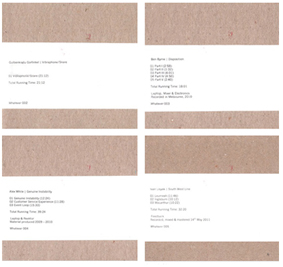: avantwhatever label collection

Avantwhatever 002-005
avantwhatever 002-005
www.avantwhatever.com
Avantwhatever is the organisation established by Ben Byrne to promote and publish his own works and those of his peers through concerts and also limited edition CDs. Matt Chaumont’s Linea started the collection in 2010 (reviewed here) with offerings by Arek Gulbenkoglu and Dale Gorfinkel, Alex White, Ivan Lysiak and Byrne himself coming out in reasonably rapid succession. While each of these artists has a distinctive approach, there is a shared sense of austerity—a serious, focussed and unadorned investigation into the essence of their materials—giving Avantwhatever a ‘house style,’ also reflected in the almost identical covers made from basic brown recycled paper.
002 gulbenkoglu gorfinkel, vibraphone/snare
Vibraphone/Snare, a single track running for just over 21-minutes, is an improvisational pursuit of vibration. Gorfinkel on prepared vibraphone and Gulbenkoglu on snare, are united in their love of small motors that they apply to their instruments (Gorfinkel also utilising the inbuilt motor of the vibraphone) and it is often impossible to tell who is generating which sound. The hum of insect-like motors underpins nearly everything, however the detail is in the changing pitches of the drives and the range of rattles, flaps and rumbles elicited from various applications. The materials dictate the structure, as new tones and hums, semi-regular rhythms and unforseen eruptions guide the players into the next moment. The recording (Rosalind Hall) is also unfussy, with a central focus, and not so much sense of the room in which it is performed. Small details play out on the edges of the stereo field, but never distract from the core of sounds in the middle. There’s no adornment here, only actions and sonic consequences blurring to create a kind of ascetic music.
003 ben byrne, disposition
Byrne’s contribution on laptop, mixer and electronics is the shortest of the selection running at 18-minutes. There is a clear sense of structure, both within the pieces themselves and the composition as a whole, divided across five distinct sections. “Part I” introduces Byrne’s sounds, dense with digital bleeps, spurts, glitches and fricatives always kept on the edge of chaos. “Part II” introduces a brief and elusive calm in the form of high, pinging, tinnitus-like tones. This is rudely swept away by “Part III”—the longest track and offered as a centrepiece of abrupt eructations, all angles and sudden shifts, with big fat squelchy sounds coarsely ground. “Part IV” maintains tension, and while never approaching figuration, seems darker and more urgent, with insistent longer tones and a clearer feeling of phrasing. Finally “Part V” seems to combine approaches from all the previous sections, somehow offering a simultaneous sense of fragmentation and sustain. While it’s a short set, the focus on structure makes Disposition satisfyingly intense.
004 alex white, genuine instability
The loudest and nastiest sounding of the collection, White’s CD Genuine Instability, made using Reaktor software, offers the most emotionally engaging listening experience perhaps because it’s the first of the series to use figurative track names. The title track, “Genuine Instability,” offers just that with signals pushed until they disintegrate; wide, dirty tones stretching and breaking across the stereo field; coarse granules disappearing into split second silences. “Customer Service Experience” is full of insistent, insect buzzes and heavy electromagnetic sounding hum. Phrasing is strong as sections shift in and out of focus, agilely scanning through the frequency spectrum and petering out to high impotent pings. “Event Loop” also delivers on its promise with a densely textured phrase that loops for over 15-minutes, but which invites an almost psychotic attention to detail as you start to hear minuscule shifts in the static. Best at volume, White’s work becomes visceral, curiously embodied despite its utterly digital origins.
005 ivan lysiak, southwest line
For this release, Ivan Lysiak works purely with feedback generated from guitar, amps and pedals. Each of the three tracks, named after train stations on Sydney’s south- west rail line, runs to just over 10-minutes with each exploring a different feedback pursuit. “Leumeah” works with a mid-range pure tone that develops octave harmonics devolving in to lower hums. Silence is allowed as signals falter and break, only to be built up again. Most surprising is a kind of trumpet-like repeated note that finally devolves into a flat nasal whine. “Ingleburn” works with a higher tone, over- and under-tones hovering on edges that eventually invade and morph into low flutters. The final track “Macarthur” surprises again with faster transitions between notes and a growing, crackly electrical interference that Lysiak shreds into ever-smaller units. South West Line is sparse, yet never static, with a constant sense of sound waves in motion, evolution and entropy.
Avantwhatever recordings are quintessentially and unapologetically difficult listening. Having heard all these artists play live, there is definitely something more satisfying in experiencing their works live and in the moment, no matter how much or how little gestural performativity is needed to make them. A large sound system and the collective listening experience better allows for the level of concentration required to really appreciate the impact of these sounds. However it’s important that these practices are documented, and Avantwhatever is creating a vital collection of some of the most interesting and challenging music currently being made.
Gail Priest
RealTime issue #105 Oct-Nov 2011 pg. web






